
Property Market Insights
Quarter 2, 2019
Welcome to the Q2 Market Insights for 2019 from National Property Buyers, where our local agents provide expert analysis of property markets across the country.
National Property Market Overview
Well, what a quarter. Quarter 2 2019 had absolutely everything going on and at the same time not much going on.
“A” grade stock and listings across the board were down. Homeowners that weren’t under pressure to sell were sitting on their properties and refusing to list them in an unstable market environment. Investors who were interested in buying but unsure of market conditions were also sitting on their hands.
Federal Election
It felt like everyone was waiting to see how the events of May 18th, the Federal Election, were going to unfold. And though it was a big upset that the Liberal party retained power the vast majority of real estate players and home owner’s breathed a sigh of relief on Election Day.
Labour’s contentious proposal to remove negative gearing on established properties and increase the amount of capital gains tax payable had the investor market unsure what the future would bring.
First Home Buyers were offered a leg up by both parties. Eligible homebuyers could purchase a house with a deposit as low as 5% and not have to take out Lenders Mortgage Insurance. The First Home Loan Deposit scheme backed by the government would commence from 1 January 2020.
Reserve Bank
The election was not the only big news in Quarter 2.
For the first time in almost three years, the RBA changed the official cash rate. In a historic move, the Reserve Bank cut the cash rate by 25 basis points to a record low of 1.25 percent. This marks the first move in the official interest rate since August 2016, when the RBA dropped the cash rate from 1.75 percent to 1.5 percent.
Two of the four (Commonwealth and NAB) big banks matched the interest rate cut, with ANZ and Westpac taking heavy media fire for only passing on 0.18% and 0.20% respectively.
Many leading finance experts predicted that the RBA would cut the cash rate again in August. And they were right! The RBA cut the rate to a new record low of 1%. The Commonwealth Bank, National Australia Bank, and Westpac have only passed on the rate cut in part to their home loan customers, while the Australia and New Zealand Banking Group (ANZ) is the only bank to confirm it would pass on the rate cut in full.
APRA (Australian Prudential Regulation Authority)
And if that wasn’t enough APRA has proposed loosening the screws on borrower lending.
In December 2014 APRA directed lenders to impose a serviceability assessment that incorporated a buffer of at least two percentage points above the loan product rate they were offering and a minimum floor rate of at least 7%. This meant the lenders had to satisfy themselves that the borrower could cope with 7% even if the mortgage rate was 4%.
APRA’s proposal to scrap this rule has been reported on widely. Warren Hogan, from Smart Property investment “my calculations suggest it would increase the borrowing capacity of home buyers by as much as 10%, enough to have a material positive impact on the housing market.”
UPDATE 5th of July – APRA has finalised its proposed changes to the serviceability assessments performed on residential mortgage applications, effective immediately. The regulator confirmed it will no longer expect lenders to assess home loan applications using a minimum interest rate of at least 7%. Instead, ADIs will be able to review and set their own minimum interest rate floor and utilise a revised interest rate buffer of at least 2.5% over the loan’s interest rate.
Forecasts
Quarter 2 has ended very differently from how it started.
Buyer confidence is returning to the market, numbers are up at auctions and clearance rates are improving. National housing market conditions continued to improve through June, with CoreLogic reporting a 0.2% fall in national dwelling values; the smallest month-on-month decline in the national series since March 2018.
CoreLogic’s June report showed home prices nationally fell 0.2% in June from May, when they eased 0.4%. The pace of decline has gradually slowed since December when prices slid 1.1%. Home values in Sydney inched up 0.1% last month, marking its first monthly rise since July 2017. In Melbourne, prices rose 0.2%, recording the first increase since November 2017.
Australia’s housing market downturn appears to be coming to an end but what is under the debate is the timing. Some leading economists predicting a spike in house prices as soon as July whilst others are predicting that house prices will continue to fall (primarily in Sydney and Melbourne) before rising “modestly” in 2020”.
AMP Capital chief economist Shane Oliver stated “The combination of the removal of the threat to property tax concessions, earlier interest rate cuts, financial help for first home buyers and APRA relaxing its 7 percent interest rate test points to house prices bottoming earlier and higher than we have been expecting,”
Read on for our capital city and state reviews by our State Managers in Melbourne, Brisbane and Adelaide.
Sections: Victoria | Queensland | South Australia

State Overview
Phew! What a quarter.
The one with everything going on and the one standing still at the same time.
We frequently talk about markets within markets but maybe we should talk about buyers within buyers. This market really separated the types of buyers out there. There were those with the appetite for risk and knew there was opportunity in this market. Opportunity to upsize your family home or opportunity to buy an astute investment for the long term. There was also the ‘wait and see’ buyers, the ones that want to wait until every loose end was tied up; the upcoming election, the prediction that the RBA will drop interest rates and the rumor that the screws on lending might loosen. A significant number of buyers had their hands in their pockets and equally, sellers did too.
The reluctance of sellers to list their properties has created a shortage of stock, especially “A” grade property. This time last year over 16,000 auctions had taken place and at the same time this year we will be lucky to reach 10,000!

Source: REIV Stats
However, a rise in clearance rate indicates that buyer confidence is returning, albeit slowly, now that all the loose ends have been tied down. In Quarter 1 the average clearance rate hovered around the 50th percentile and in Quarter 2 it is frequently achieving a weekly clearance rate around the mid 60’s.
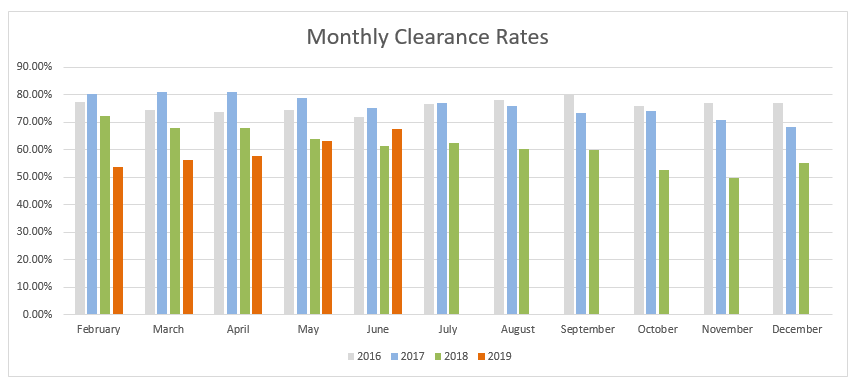
Source: REIV Stats
Traditionally, the majority of our Buyer Advocate clients are investors but lately, owner-occupiers are dominating our books. It is great that the value of a BA is being recognized by a greater cross-section of the market but it does lend further evidence that many investors have been dormant to date. Owner-occupiers are taking advantage of the drop in the prestige market. Corelogic, reported that the most expensive quarter of dwellings in Melbourne recorded a -13.8% decline in the 6 months ending May 2019. However, this rate of decline has slowed and is the smallest since November 2018.
Infrastructure
Recently Property group CBRE analysed a number of recent and planned metropolitan railway projects around Australia and their impact on their surrounding areas. Their findings were released in their report ‘A New Train of Thought’.
In Melbourne, they reviewed the Melbourne Metro Tunnel which will establish five new stations across the Melbourne CBD, St Kilda Road, North Melbourne and Parkville. The proposed loop will be Australia’s first concentric rail and provide greater access to major universities, employment hubs and the Tullamarine Airport. Due to the stations being in established city-fringe locations there will be limited associated development apart from high density residential and mixed-used developments. Most projects are to be located in Arden (Urban Renewal Precinct 2kms from CBD) and North Melbourne.
Stated in the report is investment into metro rail infrastructure is planned to increase by 107 percent over the next seven years, and it is predicted to flow through into the residential property market.
Next Quarter
Market sentiment is changing, and whilst we don’t expect a sudden rise in prices we are seeing more competition at auctions. Instead of the 1 or 2 bidders we were seeing in quarter 1 it is now common for ‘good’ properties to see 3 or 4+ bidders.
Melbourne’s housing market downturn is coming to an end, with leading economists predicting an increase in house prices as soon as July. And whilst we don’t predict a sudden surge in growth, the lack of quality stock of the market is definitely increasing competition.
Reservoir - "Reserve your judgement"
Overview
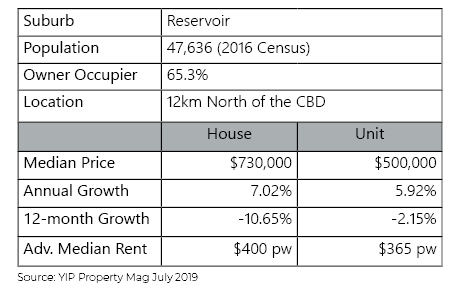 Reservoir is located 12 kilometres north of the CBD. Bounded by the Merri Creek in the west and the Darebin Creek in the east, Reservoir is a mixed-use suburb in Melbourne’s north. Reservoir is one of the largest geographical suburbs in Melbourne. And prices vary significantly, accordingly.
Reservoir is located 12 kilometres north of the CBD. Bounded by the Merri Creek in the west and the Darebin Creek in the east, Reservoir is a mixed-use suburb in Melbourne’s north. Reservoir is one of the largest geographical suburbs in Melbourne. And prices vary significantly, accordingly.
The suburb has significant industrial areas in the west and a commercial focus around its railway stations (yes, Reservoir is big enough that is has 3 railway stations!) and along Broadway (the main strip).
Currently underway is the removal of the Reservoir level crossing by building a rail bridge over the High Street and constructing a new Reservoir Station. As part of the project, a new public plaza and improving shared use paths for pedestrians and cyclists. Construction has started with the project completion expected in 2020.
The suburb contains plenty of shopping options, popular recreation areas and facilities. The Summerhill Shopping Centre which opened in 2015 has everything you need, including major supermarkets, medical centres and boutique shopping. Edwardes Street and Broadway provide further boutique shopping options and cafes and restaurants. It is currently being impacted by the level crossing removal but will be a reinvigorated strip upon completion. And if you happen to have a sweet tooth, we highly recommend visiting Sargan’s Cakes which open in 1952 and provides the most delicious pies and cakes!
Recreation and outdoor facilities include Edwardes Lake and the Reservoir Leisure Centre. There are early learning centres, a number of primary schools, the Reservoir Private Hospital and nearby the Austin Hospital. Easy access to Lygon or Brunswick Street or a short drive to Highpoint Shopping Centre, and La Trobe and RMIT Universities all increase Reservoir’s appeal.
Reservoir is an established suburb with standard brick homes, weatherboard homes, and an increasing number of new developments. Allotments are large and most houses have garages and driveways which gives the area a feeling of spaciousness which is disappearing in neighbouring suburbs Coburg and Preston. Reservoir has an inner suburb feel but without all the cars parked in the street.
Reservoir is definitely benefiting from gentrification but there are pockets that are better than others. We recommend focusing your attention around Reservoir Train Station. Stay close, but not too close! Oakhill Estate holds most of Reservoir’s prestigious streets although Olive Street, Ashley Street, George Street and Edwardes Street provide some great alternatives.
Purchase Example
 This 2 bedroom new build in Reservoir is the perfect set and forget investment. Low maintenance, full depreciation, courtyard, in a boutique block of 4 but feels like a standalone property.
This 2 bedroom new build in Reservoir is the perfect set and forget investment. Low maintenance, full depreciation, courtyard, in a boutique block of 4 but feels like a standalone property.
Conveniently located within moments of Reservoir Views Primary School, Ruthven train station, the Metropolitan Ring Road, Reservoir Village shops and cafes, the trendy High Street strip and an assortment of parks. Purchased in May 2019 for $610,000
Glenroy - "Location, Location, Location"
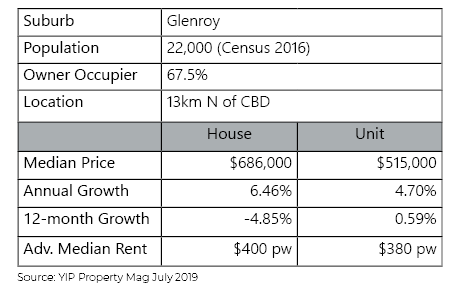 We first reported Glenroy in Quarter 3 2017 and it only a stone throw from Reservoir. When we first recommended Glenroy the median house was $666,035 and is now $692,500 (according to realestate.com.au). That is a $20k value growth in a down market!
We first reported Glenroy in Quarter 3 2017 and it only a stone throw from Reservoir. When we first recommended Glenroy the median house was $666,035 and is now $692,500 (according to realestate.com.au). That is a $20k value growth in a down market!
And remember medians are at a macro level and apply to ‘good’ and ‘bad’ properties in the suburb. When using a Buyers Advocate service only the cream of the crop are selected for clients (according to budget).
Glenroy is 13 km north of Melbourne’s CBD and is a large suburb with a population of approximately 22,000.
Glenroy is well serviced by infrastructure with Glenroy station, numerous parks and easy access to the Western Ring Road to get in and out of the city. There is a major retail district and a developing café scene. It is also home to the exclusive Northern Golf Club & neighbours Oak Park which has a new $27M Aquatic Centre being built.
The majority (63%) of properties are houses, followed by semi-detached terraces (27%) and flats (9%). There has been a shift in demographics with older age groups reducing and the predominant age group becoming 25-34 years and are primarily couples with children.
Back in the 1950’s there were many Housing Commission properties built on large quarter acre blocks which have since been developed into smaller allotments making them more affordable for young families.
There has been a shift in demographics with older age groups reducing and the predominant age group becoming 25-34 years and are primarily couples with children.
Purchase Example
 Brand new and beautifully appointed, this sensational Townhouse set in a boutique block of only three, delivers a lifestyle of easy-living excellence with its creative floorplan, designer style and much looked-for urban convenience. Offering a DOUBLE garage seldom seen, chic and trendy kitchen plus a private courtyard to unwind in, you will want to call this your home.
Brand new and beautifully appointed, this sensational Townhouse set in a boutique block of only three, delivers a lifestyle of easy-living excellence with its creative floorplan, designer style and much looked-for urban convenience. Offering a DOUBLE garage seldom seen, chic and trendy kitchen plus a private courtyard to unwind in, you will want to call this your home.
Sold on 05 Jun 2019 for $625,000
Viewing listing here.
by Antony Bucello
Director and Victorian State Manager
 Antony is married with 2 children and lives in Lower Templestowe, Victoria. Educated at Swinburne University, his sales and marketing career has spanned over 30 years in both the Financial Services and Property sectors. Having been involved in countless property purchases for his clients over the years, he is now a leading Melbourne Buyer Advocate.
Antony is married with 2 children and lives in Lower Templestowe, Victoria. Educated at Swinburne University, his sales and marketing career has spanned over 30 years in both the Financial Services and Property sectors. Having been involved in countless property purchases for his clients over the years, he is now a leading Melbourne Buyer Advocate.
0418 131 950 or email me

Market Overview
Brisbane just keeps moving along.
REIQ’s Queensland Market Monitor reported that the Queensland residential property market has “historically delivered consistent growth which has put us in an enviable position. Despite a nationwide trough, the property market in Queensland remains affordable and continues to show signs of sustainable growth when compared to its southern counterparts.”
Whilst Queensland did not experience the downturn that some of its sister capital cities did, the simple fact that there are fewer investors in the market nationally, due to stricter lending criteria and reduced buyer confidence, it is impacting us.
In times like this, there are very much two different types of investors – Speculators and Doers. Speculators are constantly waiting for that one perfect property with the lowest possible price point to fall in their lap. Doers recognise the opportunity this market presents – that whilst competition has decreased it is the best time to buy. There is nothing wrong with being a speculator and it is the most common type of investor out there. But if you want to get ahead in real estate you need to recognise the opportunity a slow market represents and buy a well-located property and hold it for the medium to long term.
The Queensland Market Monitor reported that supply was on the rise and demand slowing for the majority of housing markets in Queensland for Quarter One. The median listing duration lengthened by 5 days despite there being a larger pool of options for potential buyers and investors. And we witnessed that at the start of Quarter 2. However, now that we are in a post-election world and lending conditions may have softened slightly buyer confidence is certainly returning. In a market that has been dominated by owner-occupiers we are seeing investor inquiry increase. In the two weeks following the election results investor inquiry tripled at our local office!
Auction Clearance Rates
The auction clearance rate has remained relatively stable for the 2019 calendar year, albeit a little lower than previous years. Auction clearance rates can be an indicator of property market health, however in Brisbane and greater Queensland the majority of property sales are private treaty. Less than 30% of homes are sold via auctions.
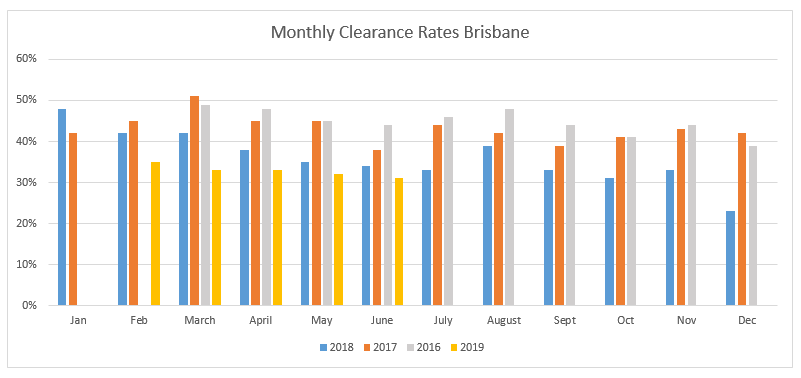
There has been a dip in the number of properties sold at auction but this correlates to the fact that fewer properties have been listed. This is mainly due to the doubt around the election and a lowered confidence in property sentiment.
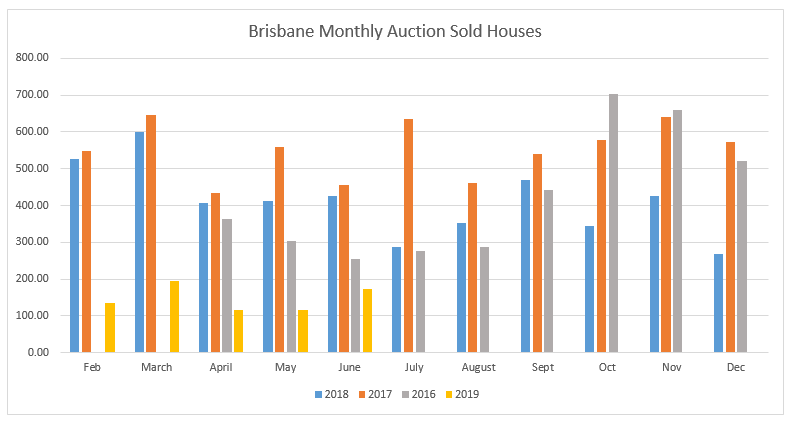
Sunshine Coast
The Sunshine Coast region, in particular, Noosa, was again the strongest performer analysed in the QMM. Noosa outperformed overall market on average, posting an annual return of 8.7 percent for houses and 6.8 percent for units.
The Queensland Market Monitor reported that ‘the annual median house price grew 8.7 percent for the year, reaching $750,000 in March 2019 despite an approximate 20 percent fall in sales. This equates to an increase in value of $60,000 over a 12 month period – an equivalent of approximately $5,000 per month.
The Urban Developer just released a report on the $430m development of the Sunshine Coast’s new CBD. Over recent years the Sunshine Coast has attracted billions of dollars in public and private investment, making the regional economy one of the strongest in the state.
On completion, ‘The Bright City’, as it’s been dubbed, will be a sprawling hub of commerce, technology, innovation, entertainment and inner-city living. Providing 65,000 sqm of dedicated retail, 2,100 residential apartments, 250 hotels rooms, 150,000 sqm of commercial space and 40% of the city will be open space and waterways. The Sunshine Coast Council has estimated up to 2 million more passengers would be flying into the region by 2040 once the region’s expanded airport was operational by 2020.
Ahead.
Brisbane’s property market is quite often referred to as the ‘steady performer’ and we believe it will continue to be so. There is a significant number of infrastructure projects across the capital city and they are expected to increase employment opportunities and housing demand.
The managing director of BIS Oxford Economics, Robert Mellor predicted that “Brisbane could be looking at up to 20 per cent growth over the next three years.”
The affordability of Brisbane properties allows investors that are priced out of Sydney and Melbourne enter the property market and begin their wealth-creation journey in a major capital city.
We expect supply to continue to rise as we don’t experience the dip in listings in Winter that our southern counterparts do. “A-grade” investment stock however will remain fairly limited as buyer and seller confidence returns slowly to the market.
Carina Heights - "Finding its identity"
Overview
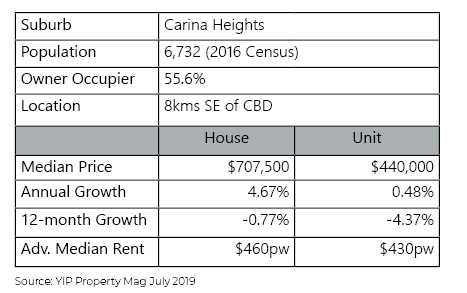
Previous over development risked ruining this attractive suburb that had plenty of potential.
A few years back development overlays seemed to give carte blanche to single dwellings being pulled down and townhouses and units being squeezed into every available space.
Local streets and neighbourhoods were overrun with development sites and builders and tradie cars and utes.
Once sites were completed the change in housing density increased traffic on the local road. Local residents lobbied the council and complained that Carina Heights was losing its family identity. The council listened and peeled back development. And just in the nick of time. Development slowed and Carina Heights has begun to rediscover itself.
But why was it so popular in the first place? Carina Heights is a suburb of Brisbane, Australia. It is located 8 kilometres south-east of the CBD, and borders Camp Hill, Carina, Carindale, Holland Park, and Mount Gravatt East. A 25-minute drive will get you into town and its easy access to the Gateway Motorway will get you anywhere else you need to go. There is no local train station in Carina Heights but there is a good bus service. Transport is easy, the main transport hub in Carina Heights Plaza is within easy walking distance from most places and brings you directly into the busway towards the city or to Carindale bus terminal. The M1 is within a 5-minute drive which takes you to the airport or the Gold Coast.
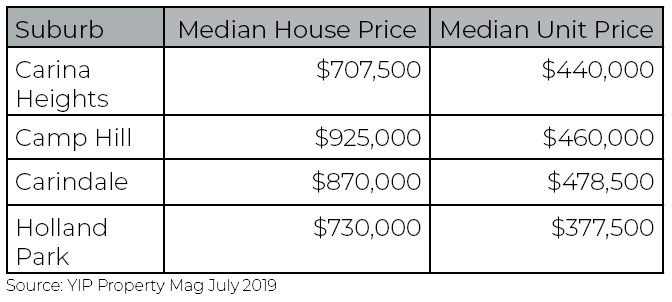
Carina Heights has a significant amount of parkland including White Hill Reserve which is shares with its more expensive neighbour Camp Hill. The reserve covers an area of over 170 hectares (420 acres). The site is popular with locals, with the reserve offering many sporting and recreational facilities.
On its eastern border is the Carindale Westfield. The centre became the third-largest shopping centre in Australia on completion of redevelopment in 2012. The centre contains over 450 specialty stores and almost 6,000 car parking spaces. There is also a very trendy Market Place shopping complex in Camp Hill. A great destination for fresh food, dining and an array of convenient lifestyle services.
For families, there are lots of schools nearby, including Whites Hills State School, Camp Hill Primary, San Sisto College and St Martin’s Catholic Primary School.
Despite being a densely populated area, it is a very quiet neighbourhood with friendly people. Young professionals/couples, retirees and young families are all enjoying what Carina Heights has to offer. Larger blocks can still be found but you have to know where to look and some of the streets offer great views over the town.
There are great opportunities to be found in Carina Height but it takes a savvy buyer (or a BA!) to secure the right place.
Riverhills - "Astonishing Value"
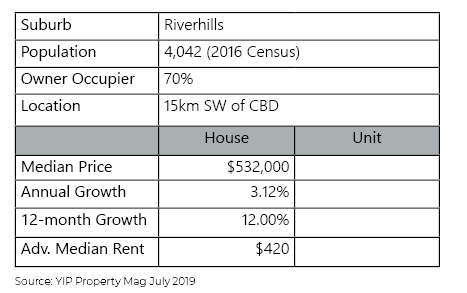
We recommended Riverhills in Quarter 1 of 2018 and in the last twelve months it has enjoyed 10.83% growth. The median price for a house has increased from $471,500 to $522,300 – a $50k difference in little over a year. An outstanding result.
We stated in Quarter 1 2018 that it was astonishing that the median house value was beneath $500k with over 50% of the population of Riverhills earning salaries in the higher income bracket $78-130k.
Situated in the “Centenary Suburbs” South West of the CBD, Riverhills is set to become very prominent on home buyers shopping lists and is currently one of the most undervalued suburbs in Brisbane.
Situated less than 15 kilometres south-west of the CBD it still offers up 80`s style predominantly brick homes for under $500k. The fact that these properties are typically on a good size 500msq+ block of land makes it a very attractive proposition to not only first home buyers but too smart investors as well.
Surrounded by golf courses, shopping centres, and a selection of schools the decision to live here is an easy one.
Access to the CBD has long been a bit of a grind but recent improvements to the centenary motorway and legacy way have eased the strain for CBD commuters a little. A regular bus service to the CBD and surrounding suburbs is also a great convenience for Riverhills dwellers.
What is another major factor in the sustainability of the suburbs value is that the Occupancy mix is over 70% owner-occupiers.
The only cautionary search definitely required for this suburb is a flood search as some of the streets were prone to flooding in 2011.
Vacancy Rates and Median Rents
Rental Market
Brisbane Q2 Vacancy Rate 2.4%, NPB Q2 Vacancy Rate 0.06%
The rental market for the second quarter was overall slower as anticipated. There was also quite a few public holidays in this quarter, which impacted on tenants moving around and enquiry level.
Fewer properties were advertised during this period, so any tenants looking for properties were limited to the options available. Towards the end of the quarter picked up due to the historic 6-month lease ending turnaround.
Houses were still the best and fastest rental – we rented all our advertised houses within 2 viewings. Units continue to be in oversupply, but if priced correctly, are renting before the existing tenant vacates.
The vacancy rate for Brisbane at the end of the quarter was 2.4%, and the NPB rate was 0.06%. Median rental rates were:
End of Q2 – Houses $461 Units $374
End of Q1 – Houses $452 Units $369
Changes in the Smoke Alarm requirements which come into effect in January 2022 require interconnected hand wired alarms to be installed in bedrooms and hallways. This is a compulsory legislative requirement and may be a major cost for most of the landlords. NPB will be able to arrange this on your behalf to ensure that your investment property is compliant with the new ruling: https://www.qld.gov.au/about/newsroom/smoke-alarm-legislation
by Stephen McGee
Queensland State Manager
 Stephen is married and lives in a bayside suburb of Brisbane. Stephen brings over 15 years of experience in residential property to National Property Buyers QLD, including residential property investment and small-scale developments. Stephen is a Committee Member of the REIQ Buyers Agent Chapter and was voted “Best Buyers Agent in Queensland” by his clients in the Investors Choice Awards of 2015.
Stephen is married and lives in a bayside suburb of Brisbane. Stephen brings over 15 years of experience in residential property to National Property Buyers QLD, including residential property investment and small-scale developments. Stephen is a Committee Member of the REIQ Buyers Agent Chapter and was voted “Best Buyers Agent in Queensland” by his clients in the Investors Choice Awards of 2015.
0488 501 170 or email me

Market Overview
Adelaide’s autumn quarterly started off slowly, seller’s hand were firmly in their pockets waiting for the up-the-coming election and it potential impacts on the property market. Adelaide did experience the smallest of declines at a macro level for dwelling value (-0.3%) in the last 12 months but there are still plenty of suburbs experiencing growth.
There is a real shortage of stock on the market, especially what we would call “investment grade” and when a quality property is listed it is certain to bring a few interested buyers to the table. Family homes are still proving popular and when one pops up in a good location it is sure to attract competition. First Home Buyers and Investors have been sitting still
Adelaide’s clearance rate has stayed fairly consistent YOY and is currently sitting around 50%. It has experienced a small drop in May and June 2019 which is largely attributed to investors and FHB sitting still.
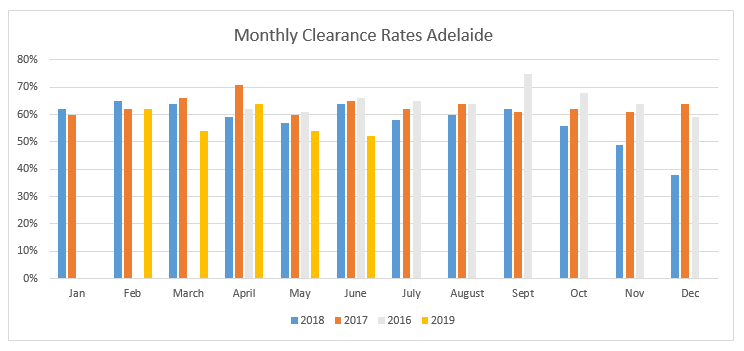
But what is interesting, unlike Melbourne or Sydney the market here is very much driven by private sales. Only about 20-30% of properties go to auction. For example, week-ending 16th of June had 82 scheduled auctions compared to 203 private sales completed.
As you can see in the chart below monthly auction sold numbers are down compared to previous years, this decline is largely attributed to a lack of stock being placed on the market.
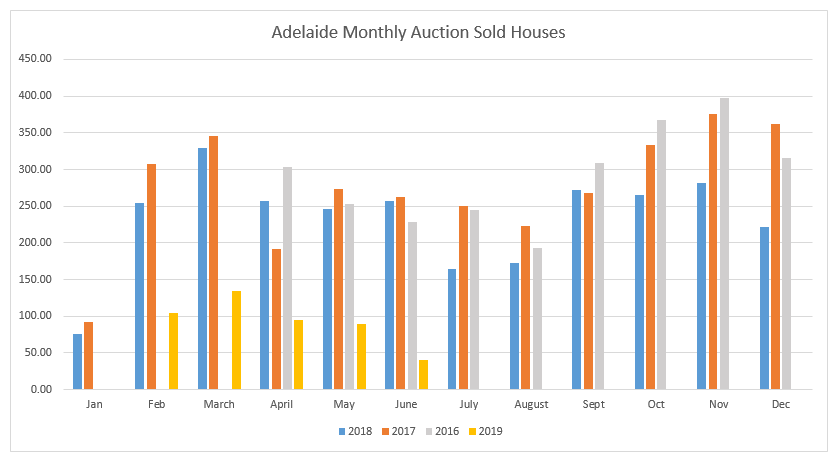
Corelogic’s recently released report “Population Growth Ramping-Up Again” revealed that South Australia’s estimated population of 1.742m increased by 0.8% ( or 14,585 persons) throughout 2018. The 14,585 person increase included natural increase of 5,490 persons, net overseas migration of 13,319 persons and a loss of 4,224 persons due to net interstate migration. Natural increase was the greatest it has been since June 2017, net overseas migration was the greatest it has been since June 2010 and the outflow of residents to other state and territories was the slowest it has been since March 2015. These figures demonstrate the ever-growing popularity of South Australia and Adelaide.
Next Quarter
Whilst the beautiful autumn selling season is over in the Hills, and the weather is turning cold we still expect the next quarter to be relatively strong. Buyer confidence is returning to the market, and investors are slowly getting their hands out of the pockets and negative gearing and capital gains reforms have put to bed for the next four years.
We do not expect any sudden spike in property values but a slow and steady increase in activity and numbers. And remember it is the turtle that wins the race, not the hare!
Kilburn - "Changing its Stripes"
Overview
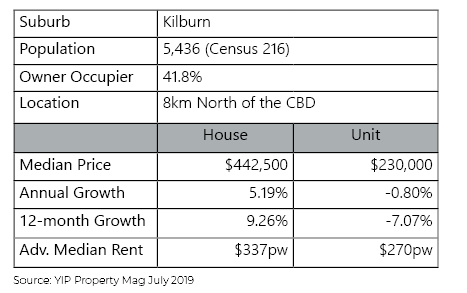
Before you google Kilburn read this.
Kilburn has an unruly past and bad reputation but it is steadily cleaning up its act.
Kilburn is benefitting from the bridesmaid effect. As buyers are priced out of its more expensive neighbours Prospect and Broadview they have started to look next door.

Let’s look at the location first. It is an inner northern suburb of Adelaide and about 10 to 15-minute drive to the CBD.
The Churchill Shopping Centre, opened in 2014, is bringing new life to the former Islington Railyards site on Churchill Road in Kilburn. It has over 50 stores covering fresh food, homewares, lifestyle, fashion and technology. From specialty retailers to major brands Churchill Centre has everything you need, including ALDI, Kmart, Flight Centre and Adelaide’s first Coles Superstore! It is the largest sub-regional shopping development in Adelaide.
And if that wasn’t you can sign up for a membership for Costco next door and shop to your heart is content. Kilburn also benefits from close proximity to Prospect which boasts many local amenities including shops, eateries, hospitals, schools and medical centres.
Kilburn also has its own train station and multiple bus routes. Public transport runs smoothly along Churchill, Prospect and Main North Roads into the city.
There is a broad selection of nearby schools to choose from, it has one school within its border and a dozen nearby in neighbouring suburbs.
Housing wise, Kilburn is slowly improving, older homes are being renovated or knocked down to make way for new builds.
Kilburn is definitely changing its stripes, but as it continues to gentrify there are definitely pockets that are better than others. We highly recommend looking around the south side closer to Regency Street.
Purchase Example
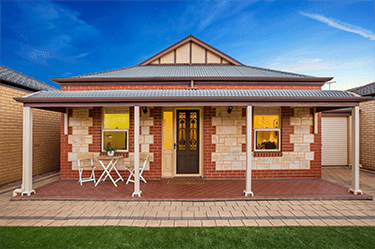 This 3 bedroom 2 bathroom home is within walking distance to Prospect Road and bus stops providing a direct route to and from the city, a three-minute drive to Bunnings, Costco and the Churchill Centre, and last but not least access to the North-South Expressway.
This 3 bedroom 2 bathroom home is within walking distance to Prospect Road and bus stops providing a direct route to and from the city, a three-minute drive to Bunnings, Costco and the Churchill Centre, and last but not least access to the North-South Expressway.
This is a relatively young property with cottage charm complete with the quality fixtures and fittings you would expect from a home built in 2006. Purchased in March 2019 for $490,000
View the agent listing here.
Broadview - "A mix of old and new"
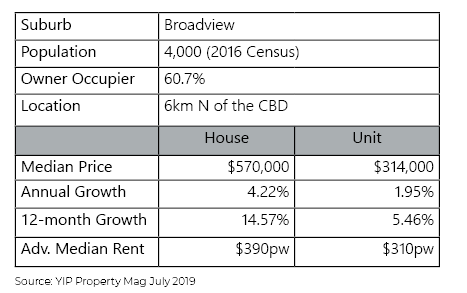 We recommend Broadview in Quarter 4 of 2017 and in the last twelve months, it has enjoyed 15.44% growth. Which is an outstanding result, especially when you consider Adelaide’s annualised growth is 3%.
We recommend Broadview in Quarter 4 of 2017 and in the last twelve months, it has enjoyed 15.44% growth. Which is an outstanding result, especially when you consider Adelaide’s annualised growth is 3%.
Broadview at only 5.8km offers a delightful mix of old and new homes. With approximately 4000 local residents, the suburb is relatively small and 60.7 (62% when we first reported) of property ownership resides with owner occupies.
What Broadview offers is true suburbia, tree-lined streets, old homes and with proximity to the CBD with those looking for a bit more entertainment.
It offers a great family lifestyle. Broadview has parks, a playgrounds and its own local primary school. It has local childcare options for pre-schoolers and nearby secondary colleges. It is a short commute to the University of Adelaide for families with older children. There is a lovely park in the area called Broadview Oval. It is very green and is excellent for playing a match of footy, soccer, cricket, and more.
Broadview is a mix of traditional bungalows and modern larger homes. Broadview is modernising and if done correctly and some of its character retained it is a good thing. Broadview is becoming more multi-cultural and its restaurants and takeaway venues are benefiting from the introduction of different cuisines. Cinemas and cafes are available in North Adelaide or drive a few more minutes to the Adelaide Market on the weekend. It’s a leisurely 45-minute walk to Melbourne Street or the Zoo. If you like the bus, they run frequently through the area. Cycling is so easy, too. The Norwood Parade is a short 10 minute drive, with Prospect Road only 5 minutes away.
Traffic can become a little congested around some of the main roads surrounding Broadview as commuters head in and out of North Adelaide and the CBD. However, Broadview is peaceful and family friendly and perfectly positioned – a 20-minute drive to the beach and 15 minutes to the CBD in peak (10 mins off-peak).
Vacancy Rates and Median Prices
Adelaide Q2 Vacancy Rate 1.1%, NPB Q2 Vacancy Rate 0.05%
With a quarter that hosted Easter, Anzac Day and school holidays and a June Long Weekend, some would have thought this may impact on tenant availability to view and move properties, but we found the opposite. A mix of apartments, townhouses and homes, both smaller and larger, were snapped up, often from the first open.
It may be the same old message, but it really does come down to marketing the individual property to the target market/s correctly, knowing the area that they are in and being realistic with rental value. Rental value can be impacted on a lot more than just the condition and position of the property; length of lease, inclusions (furniture, utilities, services) and even the likelihood of a lease continuing on past the initial tenancy. We are finding more and more tenants ask the question and it is a large consideration of whether they apply or not. Tenants are keen to know whether the property is strictly an investment property or if it is a “rental by situation”.
Winter in Adelaide is always an interesting time for rentals, but we predict properties rental values to hold steady and lease within 1-2 weeks from advertising commencing. There will always be sticky properties and highs and lows for supply and demand, but there is also always people needing housing.
The vacancy rate for the last quarter sat around 1.1%, which is relatively low and means Adelaide is still tracking well as a reliable and consistent option for investment properties.
by Katherine Skinner
Buyers Agent and Senior Property Manager
 Katherine Skinner began her career in property over a decade ago in Melbourne working in Buyer’s Advocacy and Property Management. Returning to her home town of Adelaide in 2009, Katherine quickly established a reputation as an exceptionally thorough and diligent practitioner, providing outstanding customer service coupled with a calm and positive attitude while working with some of Adelaide’s most highly regarded agencies.
Katherine Skinner began her career in property over a decade ago in Melbourne working in Buyer’s Advocacy and Property Management. Returning to her home town of Adelaide in 2009, Katherine quickly established a reputation as an exceptionally thorough and diligent practitioner, providing outstanding customer service coupled with a calm and positive attitude while working with some of Adelaide’s most highly regarded agencies.
0438 729 631 or email me
If you want to know more about any of the markets covered in this edition don’t hesitate to contact our State Managers here.
Or if you would like one of our experienced advocates to contact you to assist with your transaction, fill out our Help Us Help You form!
